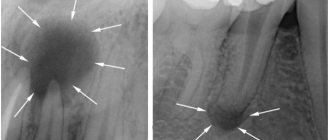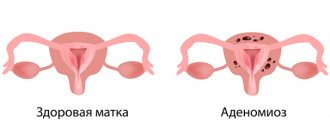An ovarian corpus luteum cyst (luteal cyst) is a benign neoplasm that matures against the background of a non-regressed corpus luteum. In the structure of gynecological morbidity in women of reproductive age, the proportion of tumor-like formations, according to world authors, ranges from 20 – 30%. Most cystic diseases of the genital organs, including various ovarian tumors, occur, oddly enough, in childhood and the neonatal period. It should be noted that a corpus luteum cyst of the right ovary in girls is found much more often than a corpus luteum cyst of the left ovary, which confirms the theory of genetic determination (definition) of earlier and more functional activity of the right ovary.
Specialists at the Yusupov Hospital diagnose and treat various benign tumors and tumor-like formations of the ovaries. When seeking medical help from hospital doctors, women are guaranteed a full clinical and laboratory examination, which includes:
- Examination by a gynecologist;
- Ultrasound diagnostics of pelvic organs;
- Dopplerography;
- Diagnostic laparoscopy.
Thanks to an individual approach to each patient, doctors at the Yusupov Hospital achieve the best results, and patients, in turn, receive attention and care from the clinic staff. The united work of the doctor and the patient on the path to recovery helps to quickly return the patient to a full life.
Corpus luteum cyst of the ovary: description and causes of formation
The corpus luteum is a special gland that is formed cyclically in the female ovary immediately after ovulation, in the second luteal phase of the menstrual cycle. During this period, the woman’s body prepares for a possible pregnancy. During ovulation, the egg is released from the follicle, after which it degenerates into the corpus luteum. The main and main function of the luteal body is to produce sex hormones: progesterone and estrogen. If pregnancy does not occur, the corpus luteum regresses and disappears. On the other hand, if fertilization has occurred, the temporary ovarian gland begins to increase in size and remains active for 10 to 12 weeks, producing progesterone, a necessary hormone for maintaining pregnancy.
If the correct formation of the corpus luteum is disrupted, fluid accumulates in it and a cyst forms. An ovarian corpus luteum cyst can reach up to 7-10 cm in size. Most often it forms in one ovary. In addition, in gynecology, there are two types of ovarian corpus luteum cyst:
- The first is developing from an atretic follicle;
- The second one occurs during pregnancy.
Among the reasons for the development of this pathology of the female reproductive system, it is impossible to identify a specific provoking factor. It is believed that the formation of a tumor-like formation of the corpus luteum is influenced by hormonal imbalance, impaired blood flow and lymphatic drainage in the ovarian tissues. Also, one can note the following reasons for the development of an ovarian corpus luteum cyst:
- Taking medications that stimulate ovulation (for infertility);
- Taking emergency contraception;
- Taking clomiphene citrate in preparation for IVF;
- Heavy physical or psychological stress;
- Harmful working conditions;
- Unhealthy lifestyle: mono-diet, alcohol, smoking;
- Chronic inflammatory processes of the female reproductive system.
Size of the corpus luteum during pregnancy
The main task of the corpus luteum is to produce hormones necessary for the further development of pregnancy. Therefore, at different times it will have different sizes. In the first days of its appearance, the corpus luteum has a diameter of 15 -20 mm. Then it increases in size to 25 - 27 mm and remains this way until about the 15th week of pregnancy. After which its functions gradually cease and its size decreases.
In some women, the size of the corpus luteum during pregnancy can be more than 30 mm, in these cases they speak of a corpus luteum cyst. However, there is no reason to worry - this cyst does not pose a health hazard and does not disrupt the course of pregnancy, since it also secretes progesterone. Some expectant mothers get scared if, during an ultrasound, the doctor does not find a corpus luteum in them. But, as a rule, the problem is not at all in the woman - most often this happens when conducting research on old equipment that has low resolution, or if the ultrasound is performed by an insufficiently unqualified doctor. Simply repeat the procedure at another medical facility.
Corpus luteum cyst of the ovary: symptoms
The clinical picture of the ovarian corpus luteum cyst is asymptomatic or mild. In most cases, ovarian tumors develop within two to three months and then spontaneously and unexpectedly undergo involution.
Corpus luteum cyst of the ovary is characterized by the following symptoms:
- Delayed menstruation;
- Breast engorgement;
- The appearance of scanty bloody discharge from the genital tract;
- Nagging pain in the pelvic organs or tingling in the ovary due to a corpus luteum cyst.
It is possible to develop a whole complex of questionable signs of pregnancy, in which it is necessary to exclude ectopic pregnancy. An ovarian corpus luteum cyst diagnosed during pregnancy does not pose any threat to the unborn child or woman. On the contrary, the absence of the corpus luteum in the early stages can provoke termination of pregnancy due to hormonal deficiency.
Corpus luteum cysts of the ovary can rupture with hemorrhage into the pelvic cavity, especially during sexual intercourse. In this case, the woman has a clinical picture of an acute “gynecological” abdomen: cramping pain in the lower abdomen, positive peritoneal symptoms, disruption of the pelvic organs, nausea, vomiting, hypotension, tachycardia, dizziness.
How the gland is examined
Examination of the reproductive organs and determination of the size of the luteal gland in particular is carried out using ultrasound diagnostics. On an ultrasound image, the corpus luteum in the left ovary looks like a heterogeneous round sac. Its absence indicates the development of the following pathologies in a woman:
- Delayed menstruation indicates problems in the functioning of the reproductive system,
- development of serious diseases in the organs of the endocrine system,
- If there is a positive test result for pregnancy and its occurrence, the absence of a gland may indicate a threat of early miscarriage. In this case, Duphaston and Utrozhestan are usually prescribed.
It is important to note that a delay in menstruation if there is a corpus luteum on the left in the picture, but the absence of a fetus in the picture, indicates that the woman is pregnant.
Corpus luteum cyst of the ovary: what to do
Specialists at the Yusupov Hospital make a diagnosis of ovarian corpus luteum cyst based on the patient’s life history and illness, complaints, gynecological examination data, ultrasound, laparoscopy, and laboratory tests. During an examination in a gynecological chair during a vaginal examination, it is possible to determine the size and localization of a hyperplastic formation in the pelvic area. The corpus luteum cyst is usually unilateral, painless, elastic in consistency, up to approximately 6 cm in diameter.
In addition, to accurately determine the luteal cyst, a dynamic ultrasound examination is performed in the first (follicular) phase of the menstrual cycle. On an ultrasound monitor, the cyst looks like an anechoic, homogeneous formation of a round shape, with smooth, clear contours.
In order to differentiate retention formations from true ovarian tumors, the Yusupov Hospital performs color Doppler ultrasound (CDC) and a study of the CA-125 tumor marker.
To exclude or confirm pregnancy, determination of human chorionic gonadotropin is indicated. Diagnostic laparoscopy is performed in the most severe cases, when clinicians cannot determine the nature of the origin of the ovarian tumor formation.
What is the corpus luteum in the left ovary
Endocrine formation, with the help of which the uterus prepares for the further development of the embryo. It is formed temporarily and is intended for the growth of the future fetus. Its tissues are lined with a yellow substance called lutein.
The size of the neoplasm on the left ovary reaches 10-27 mm. Gynecologists note that these indicators change when the phase of the cycle changes. It is important to remember that if the parameters are several times higher than normal, this indicates that the luteal gland has grown into a cystic neoplasm. Sizes below normal indicate its underdevelopment.
Ovarian cysts

Category: Gynecology.
Ovarian cyst is a common disease in women of childbearing age. Moreover, 30% of cases of cyst formation are diagnosed in patients with a regular menstrual cycle and 50% in patients with an irregular one. During menopause, the disease can occur in 6% of women.
By their nature, cysts are divided into functional and organic. The first ones are temporary and are formed due to a slight disruption of the ovary. A functional cyst is usually treated with oral hormonal medications and will self-destruct within one to two months. But there are also cysts that do not disappear for more than two months and require surgical intervention. They are usually called organic.
Follicular . The cavity of the follicular cyst has thin walls with a smooth surface, with a diameter of two to seven centimeters. Sometimes several follicular cysts may form in a section, but they are always single-chamber, without septa.
Corpus luteum cyst. Functional cyst. The corpus luteum cyst has thickened walls and can be from two to seven centimeters in diameter. The inner surface of the cyst is often yellow, the contents are light, and in case of hemorrhages, they are bloody.
Hemorrhagic. It is a consequence of hemorrhage inside a formed follicular cyst or corpus luteum cyst.
Endometrioid. Formed when the tissue lining the inner layer of the uterine wall grows in the ovaries. An endometrioid cyst is often filled with dark contents, blood, its diameter ranges from two to several tens of centimeters.
Dermoid. It represents parts of embryonic germ sheets enclosed in a mucus-like mass, derivatives of connective tissue (fat, cartilage, skin). A dermoid cyst usually does not reach large sizes and grows slowly.
Mucinous. Benign epithelial tumor. The cavity of this cyst has an uneven surface and is filled with mucin - a mucus-like liquid that is a secretion of the epithelium. A mucinous cyst can reach quite large sizes and have several chambers.
Serous. Benign epithelial tumor. The surface of the capsule is lined with serous epithelium. Contains inside a transparent liquid of light straw color.
Epithelial tumors. Develop from the epithelial components of the ovary. They can be benign, borderline and malignant.
Germ cell tumors. They account for less than 5% of all ovarian tumors. Moreover, they are characterized by the most turbulent currents. They are often quite large (more than fifteen centimeters).
Causes
There are quite a few reasons for the development of ovarian cysts:
- hormonal and endocrine system disorders
- early menstruation
- induced termination of pregnancy, including abortions
- thyroid dysfunction
- inflammatory diseases and genital infections
Complications
An ovarian cyst can have various complications:
- Some types of cysts can develop into malignant ones if they persist for a long time. It should be remembered that only histological examination can be an accurate method for diagnosing the nature of the cyst.
- Twisting of the cyst stalk, which may be accompanied by severe pain, rupture of the cyst, which may result in the development of peritonitis
- Infertility.
Diagnostics
The cyst is diagnosed using the following methods:
- Gynecological examination. Allows you to determine pain in the lower abdomen and enlarged appendages.
- Ultrasound. The most informative method, as it allows not only to determine the presence of a cyst, but also to monitor its development.
- Laparoscopy. Not only an almost 100% method for diagnosing a cyst, but also a method for its treatment.
- Computed tomography or magnetic resonance imaging. Using these methods, the benign quality of the cyst, its location, size, structure, contours and other indicators necessary for the operation are determined.
Treatment
The choice of treatment for a cyst depends on the nature of the cyst, its type and the development of possible complications. The most common functional cysts are usually treated with oral hormonal medications. Treatment for these cysts can take two to three months, depending on the size of the formation. In this case, the dynamics of treatment is monitored using ultrasound. If drug treatment is ineffective, surgical intervention is recommended.
The surgical method as the main one is most often used to treat complex cysts of an organic nature. Modern technologies involve laparoscopic intervention in such cases, allowing minimal damage to healthy tissue, minimizing complications from surgery and minimizing hospitalization time. In any case, during the operation, doctors will try, if possible, to preserve the ovary and reproductive capabilities of the patient.
In the Department of X-ray surgical methods of diagnosis and treatment of the OKDC, the following types of operations are performed for cysts and benign tumors of the uterine appendages:
- laparoscopic enucleation of ovarian cyst
- laparoscopic resection of the ovary (removal of part of the organ)
- laparoscopic oophorectomy, adnexectomy (removal of the ovary, uterine appendages)
During surgery on the uterine appendages (ovary and fallopian tube), an urgent histological examination is required, which makes it possible to accurately determine the nature of the tumor: benign, borderline, or malignant. This helps to avoid repeated surgical interventions when identifying borderline and malignant tumors of the uterine appendages. If they are detected, radical operations are performed in the RHMD department, including high-tech ones: laparoscopic extirpation of the uterus with appendages, omentectomy (removal of the uterus with appendages, greater omentum).
share information
0
Social buttons for Joomla











